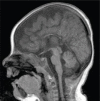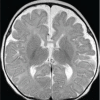A Female Child with Skin Lesions and Seizures: Case report of Incontinentia Pigmenti
- PMID: 21509293
- PMCID: PMC3074784
A Female Child with Skin Lesions and Seizures: Case report of Incontinentia Pigmenti
Abstract
Incontinentia Pigmenti (IP), (OMIM # 308300), is a rare X-linked dominant condition. It is a multisystemic disease with neuroectodermal findings involving the skin, eyes, hair, nails, teeth, and central nervous system. It is usually lethal in males; the disease has variable expression in an affected female. We report the case of a 6 month old girl who presented at Sultan Qaboos University Hospital, Oman, with neonatal seizures and hypopigemented/hyperpigmented skin lesions. She had multiple ophthalmic abnormalities and neurological manifestations which are discussed in this report.
Keywords: Case report; Hypomelanosis of Ito; Incontinentia Pigmenti (IP); Neurologic diseases; Oman; Ophthalmic; Seizures.
Figures




Similar articles
-
Neonatal seizures in two sisters with incontinentia pigmenti.Neuropediatrics. 2004 Apr;35(2):139-42. doi: 10.1055/s-2004-815837. Neuropediatrics. 2004. PMID: 15127315
-
[Variable clinical expression of familial Incontinentia Pigmenti syndrome - presentation of three cases].Med Wieku Rozwoj. 2008 Jul-Sep;12(3):748-53. Med Wieku Rozwoj. 2008. PMID: 19305025 Polish.
-
Incontinentia pigmenti and hypomelanosis of Ito.Handb Clin Neurol. 2013;111:341-7. doi: 10.1016/B978-0-444-52891-9.00040-3. Handb Clin Neurol. 2013. PMID: 23622185 Review.
-
Incontinentia Pigmenti: X-Linked Skin Disorder: A Case Report.Neonatal Netw. 2022 Mar 1;41(2):89-93. doi: 10.1891/11-T-725. Neonatal Netw. 2022. PMID: 35260425
-
Incontinentia Pigmenti.Actas Dermosifiliogr (Engl Ed). 2019 May;110(4):273-278. doi: 10.1016/j.ad.2018.10.004. Epub 2019 Jan 17. Actas Dermosifiliogr (Engl Ed). 2019. PMID: 30660327 Review. English, Spanish.
Cited by
-
The Impact of the IKBKG Gene on the Appearance of the Corpus Callosum Abnormalities in Incontinentia Pigmenti.Diagnostics (Basel). 2023 Mar 30;13(7):1300. doi: 10.3390/diagnostics13071300. Diagnostics (Basel). 2023. PMID: 37046518 Free PMC article.
References
-
- Traupe H. Functional X-chromosomal mosaicism of the skin: Rudolf Happle and the lines of Alfred Blaschko. Am J Med Genet. 1999:85324–9. - PubMed
-
- Scheuerle AE. Male cases of Incontinentia Pigmenti: case report and review. Am J Med Genet. 1998;77:201–18. - PubMed
-
- Türkmen M, Eliaçik K, Temoçin K, Savk E, Tosun A, Dikicioğlu E. A rare cause of neonatal seizure: Incontinentia Pigmenti. Turk J Pediatr. 2007;49:327–30. - PubMed
-
- Fritz B, Kuster W, Orstavik KH, Naumova A, Spranger J, Rehder H. Pigmentary mosaicism in hypomelanosis of Ito. Further evidence for functional disomy of Xp. Hum Genet. 1998;103:441–9. - PubMed
LinkOut - more resources
Full Text Sources
